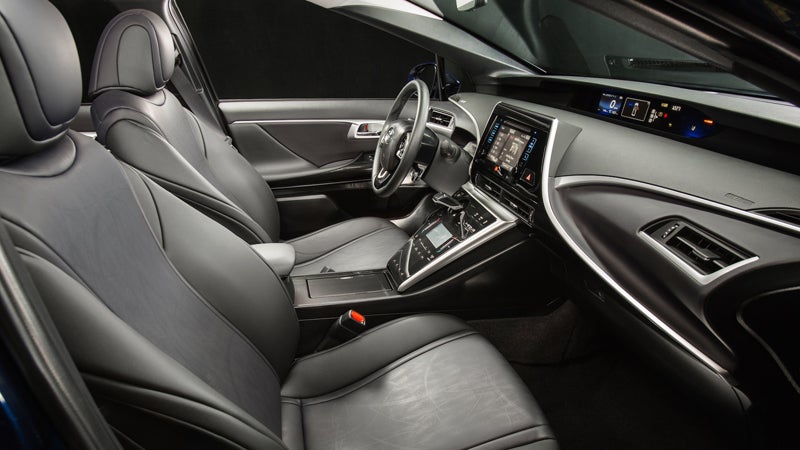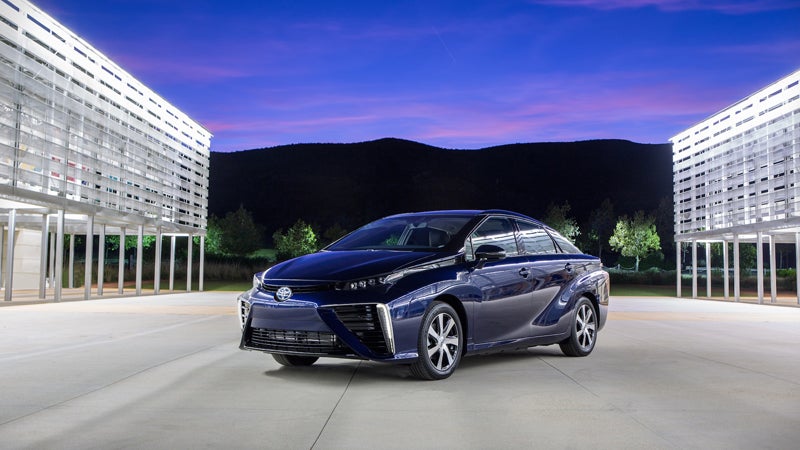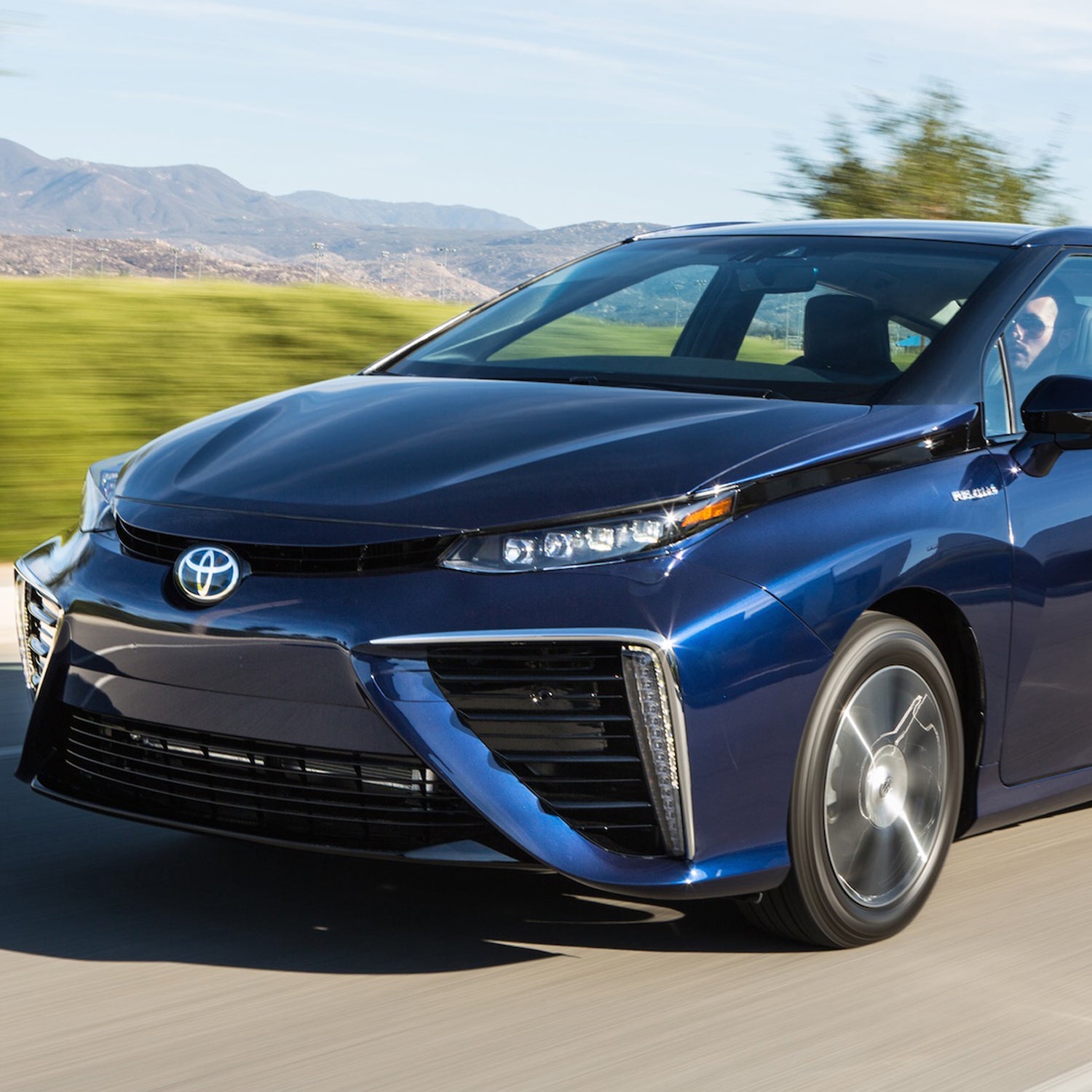Late next year, the Toyota Mirai will go on sale for $57,000. It will run on hydrogen—the only commercial car of its kind on the road—and emit water vapor from the tailpipe.
Hydrogen has the potential to be the world’s cleanest energy source. Even taking the process used to produce the element into account, emissions from a hydrogen-powered car are half what they would be from a gas-powered one.
At the moment, hydrogen is rarely produced and very expensive. But with the U.S. in a fracking boom, hydrogen-powered cars have a dependable fuel source—one that may make the industry a lot cleaner. Fracking gas byproducts can be used as a fuel for a car like the Mirai. When you convert the byproducts into hydrogen, you get power that offers a far greater automotive range. And by not burning the gas, you’re not sending the carbon into the atmosphere.

Still, why not just drive your Prius? The answer: a hydrogen-powered car is cleaner than the hybrid—assuming you spend a good bit of your time also running your Prius’ gas engine.
Okay, you might wonder, so why not buy an electric vehicle? Well, EVs suffer from limited charging infrastructure and range. A Nissan Leaf can only go about 80 miles per charge—and then it takes hours to recharge. The Mirai, on the other hand, can travel 300 miles on a tank of hydrogen and refuels in just a few minutes, just like your gas-powered car. To make an EV with similar range would require both a bigger car (lots of batteries), but you’d still face the long recharge wait—and a steep price tag. The Tesla Model S can travel up to 300 miles per charge, but it also costs upwards of $70,000.
Gas Up, But Where?
Okay, so a 300-mile range is great, but you probably noticed the lack of hydrogen fuel pumps. Toyota’s working with the state of California—where the Mirai rolls out late next year—to build hydrogen-fuel hubs in and around Los Angeles and Silicon Valley. (Toyota’s putting up some of the dough, and the state has pledged $200 million through 2020.) Toyota’s also promising to fund more pumps along the I-95 corridor in the northeast U.S.
Currently, most EV drivers use any number of apps (these come from carmakers and are readily available online) to find fast charging stations and diesel pumps. For early Mirai adopters, the experience will be the same—you’ll have a regular circuit of pumps to use. As a bonus, all that fuel will be free at the start. During the first three years of ownership (Toyota thinks most customers will opt for the three-year, $499/month lease rather than buy the cars), all hydrogen will be free.
There’s a push-pull with any new technology. Toyota acknowdledges that they’re stepping out on a limb with the Mirai, but say that when they introduced the Prius in 1997, it wasn’t an instant hit. The first one million Priuses took a decade to sell, but since 2007, seven million have sold. Granted, the Prius never had the same infrastructure impediments as the Mirai—you can gas up your Prius anywhere.
But the hydrogen pumps will come. And the end goal isn’t just to keep refining natural gas, says Ole Hofelmann, CEO of hydrogen supplier Air Liquide. In five years, Hofelmann says his company will have rolled out hydrogen production from renewable energy like solar, wind—and even garbage. In Orange County, where the Mirai launched Tuesday, a wastewater treatment plant converts the methane captured from sewage directly into hydrogen. Methane is a very volatile greenhouse gas— capturing it and converting it to fuel that emits nothing in your Mirai is the sort of energy-from-nothing miracle Toyota’s trying to sell with this car.

More likely is California’s plan to convert wind power into hydrogen. This is key to making wind (and solar) cheaper, since at present there’s no way to store the energy when demand is low. Convert it to hydrogen, however, and you create a battery model, either to run a power plant—or to sell to consumers who drive hydrogen-powered cars.
So How Does the Mirai Drive?
We had a limited test at the wheel of the Mirai, but we’ll say this—it’s a more natural driving, natural-feeling car than the Prius. Acceleration is smooth and the car’s very quick. Note that the powertrain is very similar to an electric car’s. The hydrogen passes through an exchange process where energy is extracted to run an electric motor. All of this happens seamlessly, and although there’s also a battery pack that’s charged (a la Prius), actually motoring away from a stoplight or merging onto the interstate is liquid-glass smooth. Likewise, the steering-feel is a bit less robotic than in the Prius, and because the hydrogen tanks, motor, and compressor (needed to stuff more hydrogen into each carbon-fiber tank) are all low in the car, it handles adroitly.
Short answer: It’s no sports car, but it’s surprisingly fun and agile. Like finding vegan meals that taste great, the Mirai belies its eco credentials with a lot more spunk than you’d expect.
Toyota also says you can use your car as a portable power station. While they didn’t elaborate, the idea is that you can draw DC power back out of the Mirai to either power your home during a storm-induced outage—or to run juice from it to, say, an air mattress inflator at the beach or your boom box when you’re car camping with the groms.
Yeah, But Who’s Buying?
The sticker price is steep, and the impediments to ownership of any hydrogen car are still substantial. Silicon Valley types and L.A. creative folks are almost surely going to be the first hand raisers. You’d need a steady job and a steady commute cycle to want this car, but as with any “out-there” tech, scarcity alone will make this a wannabe’s hot rod.
Then what? Mirai means “future,” in Japanese. The question remains whether after the buzz cools, Toyota can manage to mainstream the Mirai so that it’s no longer a novelty, but the kind of car we all want to own.


